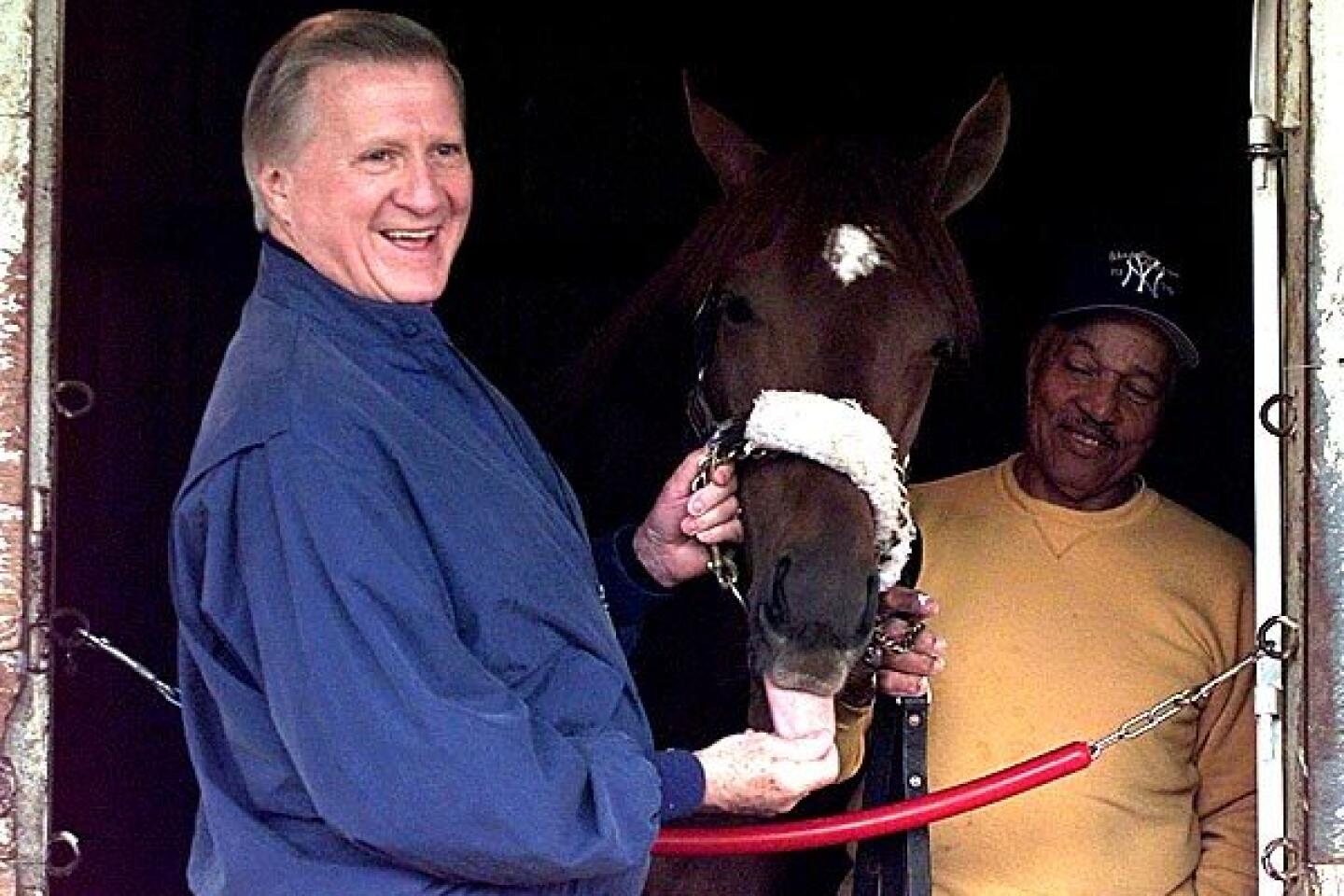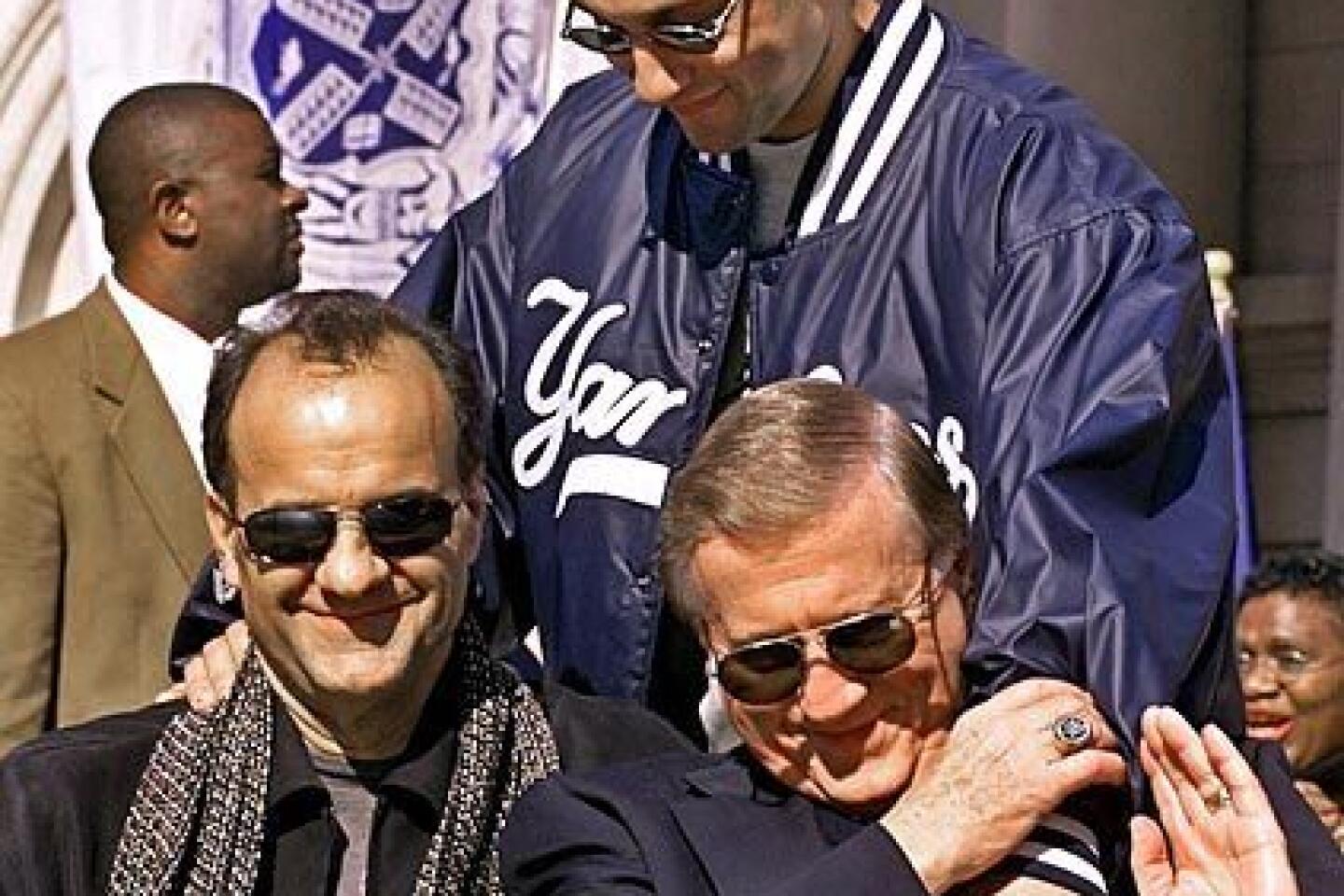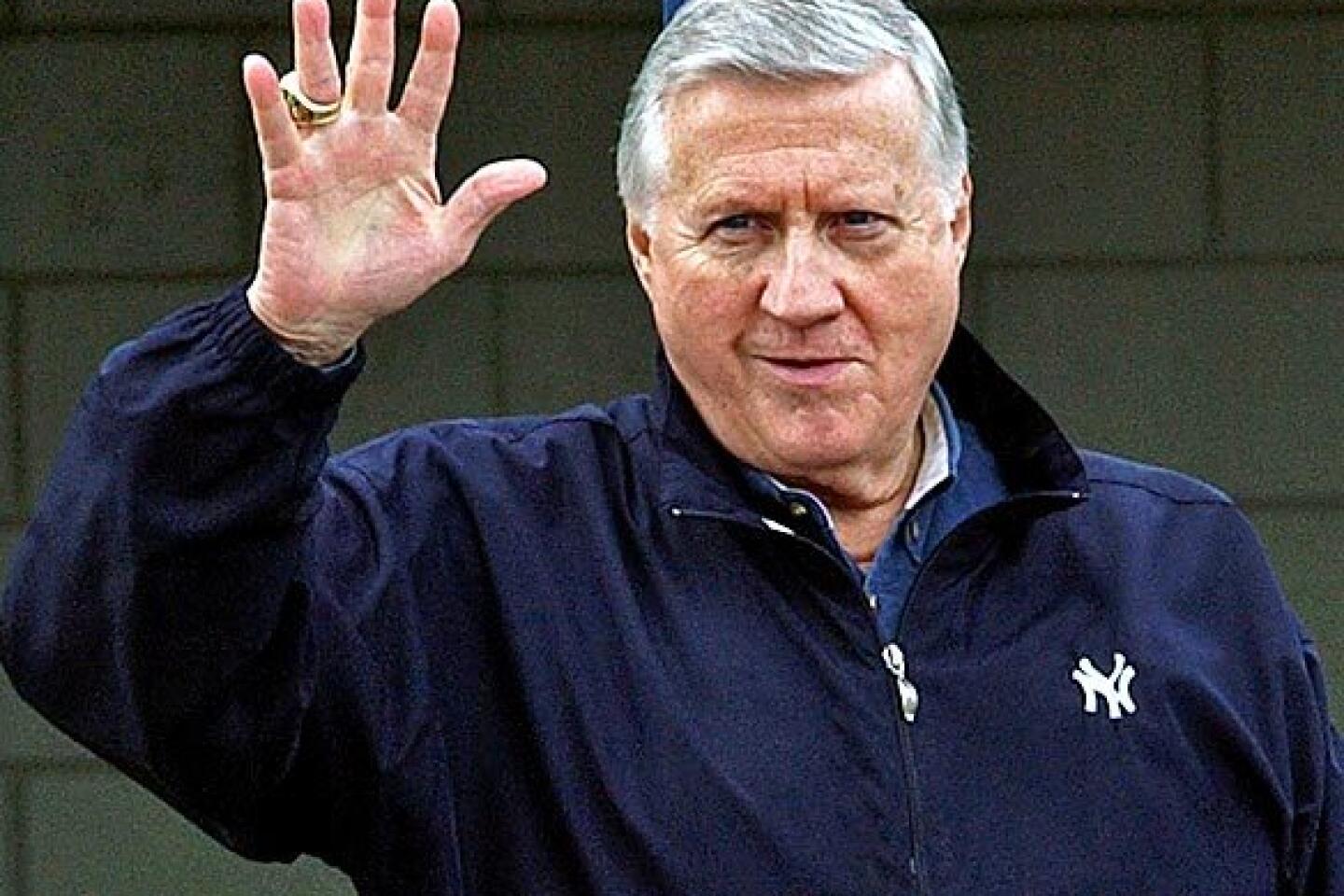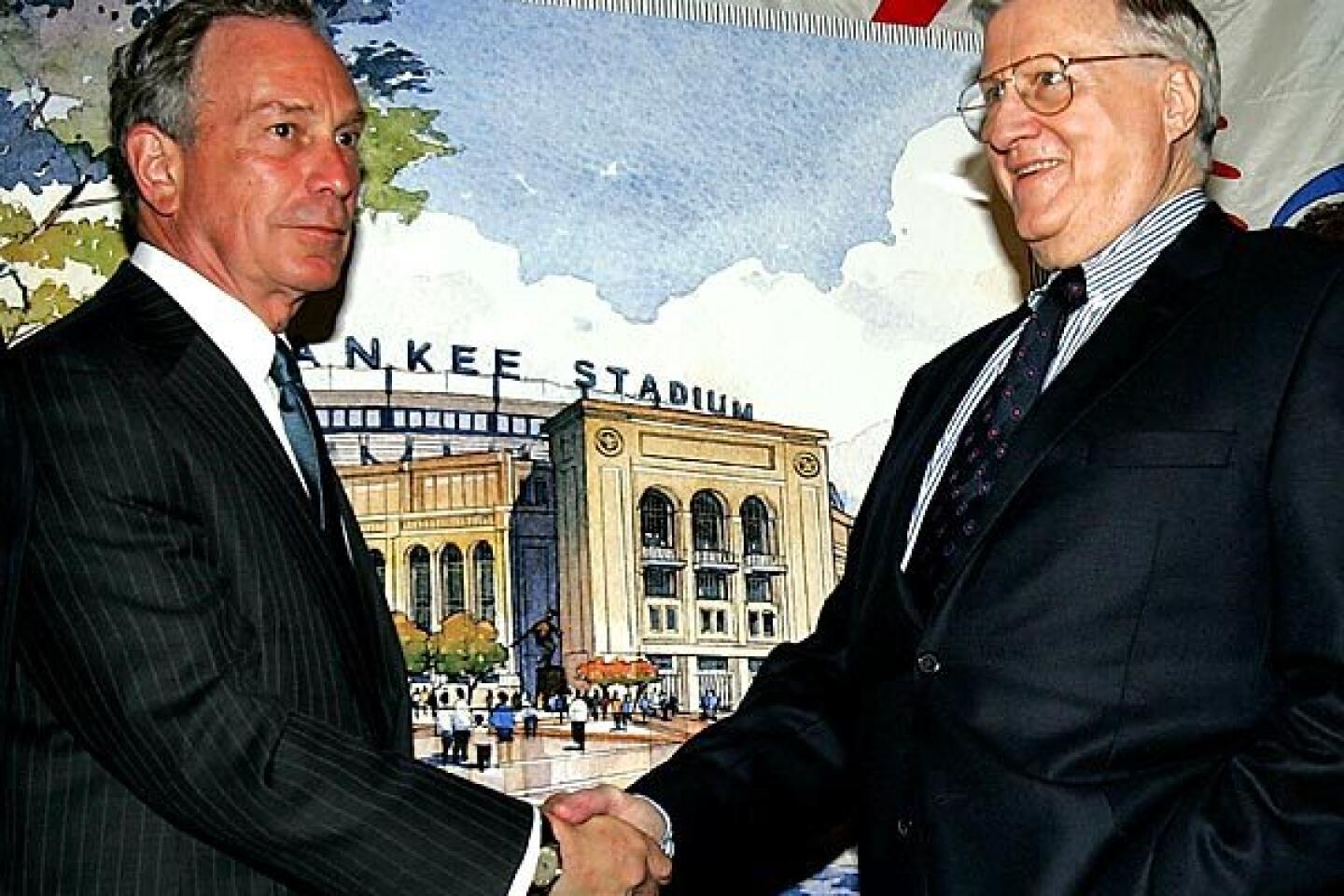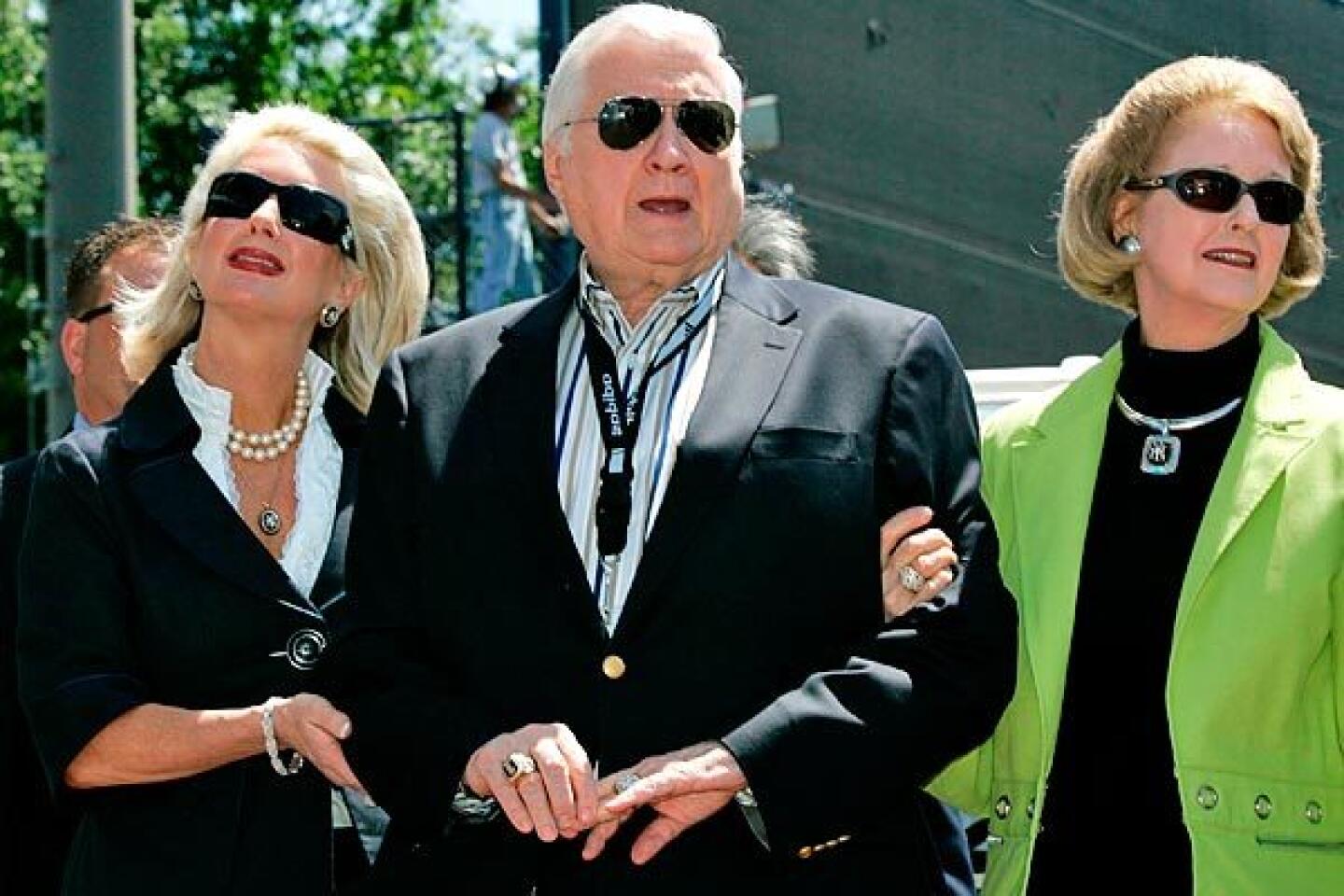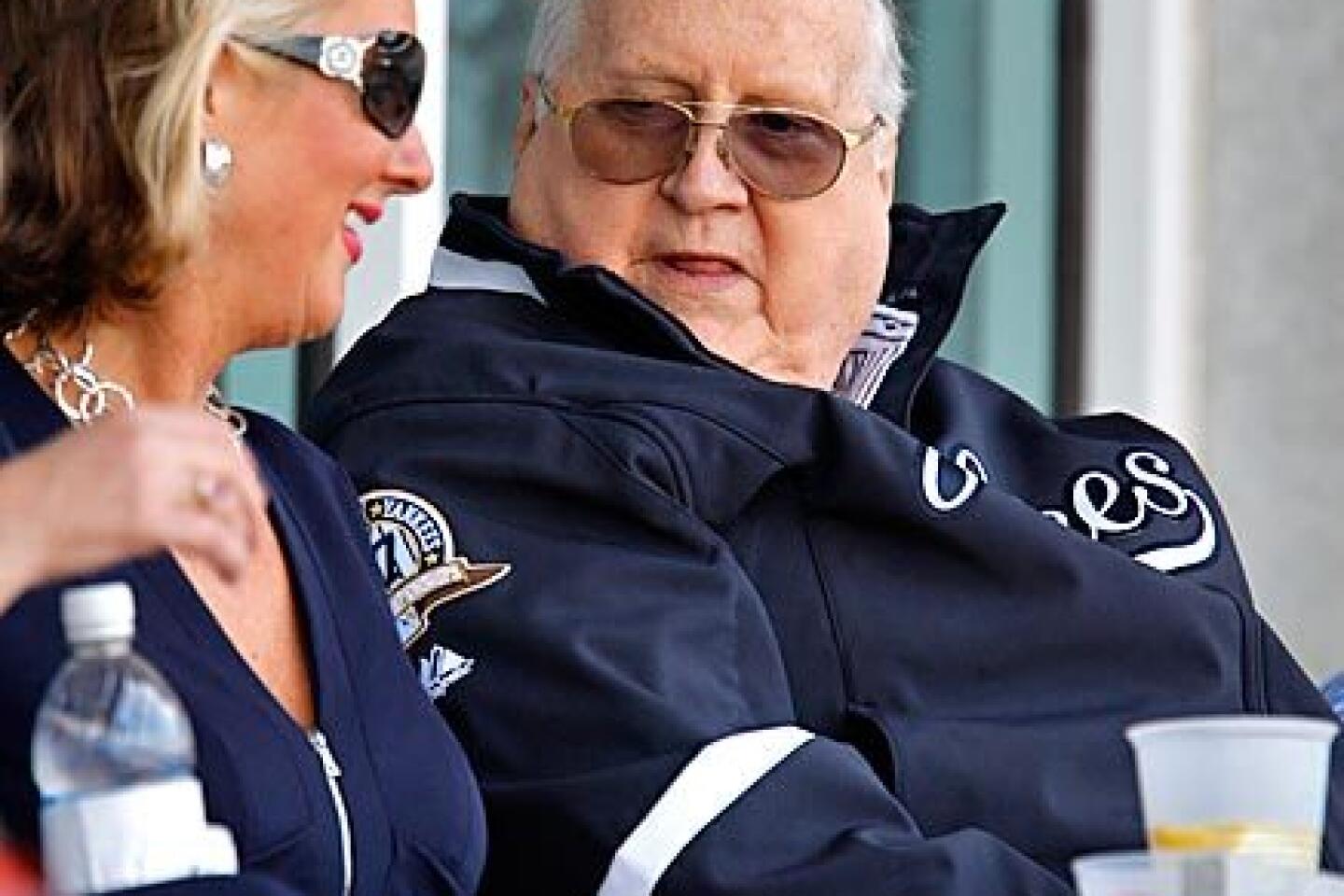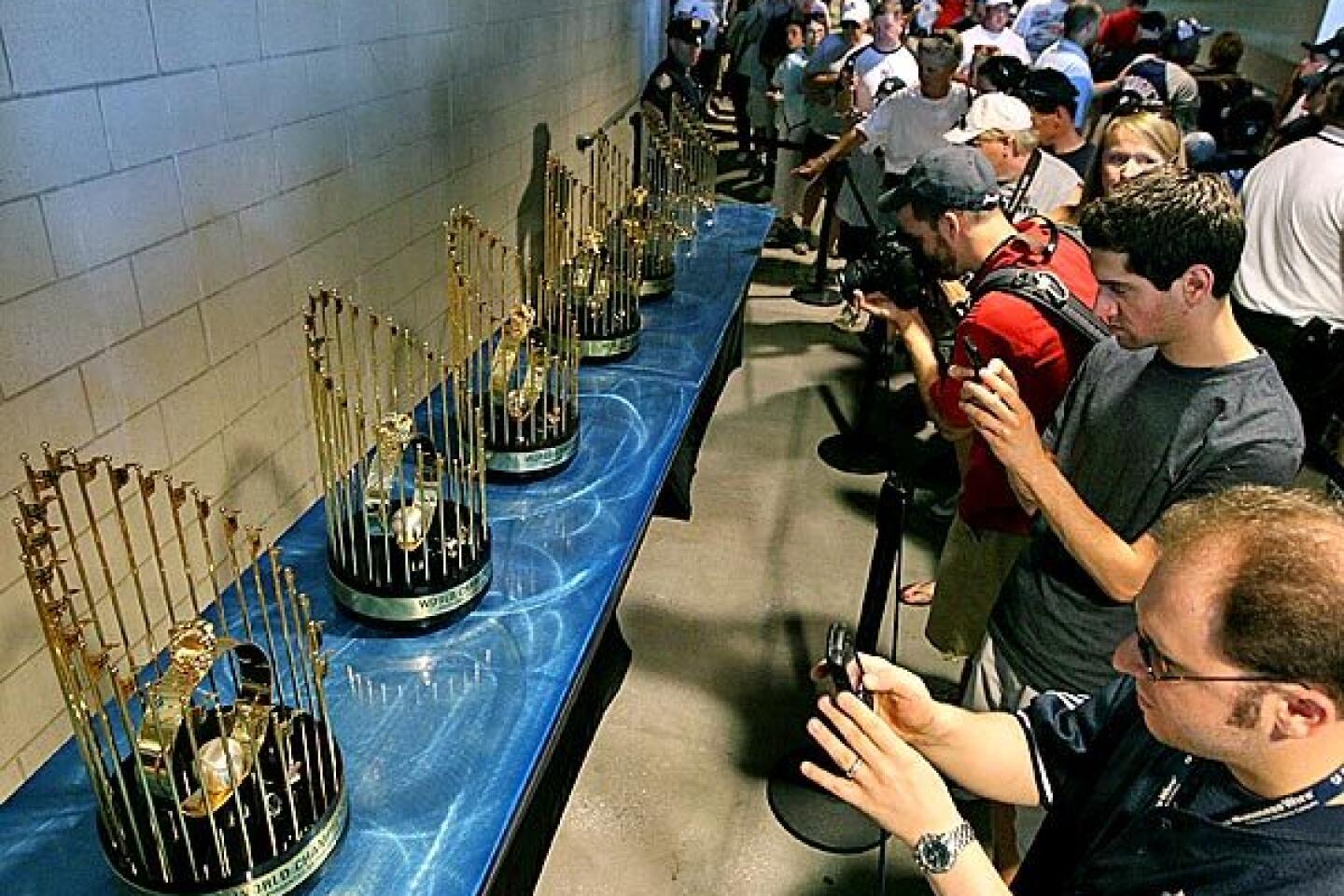George Steinbrenner dies at 80; owner of New York Yankees
- Share via
George Steinbrenner, who made his name synonymous with the revival of the New York Yankees as a dominant baseball team and leveraged multiple championships into business ventures that forever changed the economics of the sport, has died. He was 80.
Steinbrenner died Tuesday morning in Tampa, Fla., according to a statement released by his family. The cause was not given.
The death comes as Major League Baseball prepared to hold its All-Star game in Anaheim.
“He was and always will be as much of a New York Yankee as Babe Ruth, Lou Gehrig, Joe DiMaggio, Mickey Mantle, Yogi Berra, Whitey Ford and all of the other Yankee legends,” baseball Commissioner Bud Selig said. “Although we would have disagreements over the years, they never interfered with our friendship and commitment to each other. Our friendship was built on loyalty and trust and it never wavered.”
Steinbrenner ceded control of the team in 2008 to his sons Hank and Hal after a period of declining health. He attended only three games during the 2009 regular season — including two in Tampa, where he lived — but was present at the new Yankee Stadium for two games of the team’s World Series victory over the Philadelphia Phillies. He also attended the Yankees’ home opener this April.
In New York and beyond, Steinbrenner in his prime was “The Boss,” with an outsized personality and win-at-any-cost mentality, firing managers and haranguing players at will. He parlayed a $168,000 investment in 1973 into control of a team now worth more than $1 billion, flush with cash for the 21st century after launching the Yankees’ own television station and replacing iconic Yankee Stadium with a money-making duplicate across the street.
The Yankees won seven World Series championships during his 37 years of ownership, reclaiming their stature as the most storied team in American sports and redefining themselves as a brand marketed around the world.
Steinbrenner restored the Yankees to glory by embracing free agency at a time when most owners still despised it. He ultimately milked so much money out of his team that rival owners voted to institute a luxury tax that targeted the Yankees’ spiraling payroll and split the proceeds among the league’s less successful franchises.
He employed the biggest stars in baseball — Reggie Jackson, Thurman Munson, Don Mattingly, Derek Jeter, Alex Rodriguez and Mariano Rivera, among many others — but could draw more attention than his players. The television comedy “Seinfeld” lampooned him on a regular basis, he poked fun at himself as a guest host on “Saturday Night Live,” and he was portrayed with broad brushstrokes in the 2007 ESPN miniseries “The Bronx is Burning.” His trademark white turtleneck and blue blazer became costume shorthand for a boss full of bluster.
He hired Billy Martin as manager five times and fired him five times. He raged at a secretary for mixing up a plane reservation, fired her, then called the next day and arranged to pay for her child’s college education.
“Have I made mistakes? Yes,” Steinbrenner told The Times in 1998. “Are there things I would do differently? Yes.
“I’m human, and I have an ego. I’ll admit that. But, if the goal is to win, I’ll stand on my record.”
In an era when other owners trotted out talking points such as corporate synergy, competitive balance and fan experience, Steinbrenner unapologetically demanded to win. He compared owning the Yankees to owning the Mona Lisa and shot back at infielder Graig Nettles’ now-legendary quote: “When I was a little boy, I wanted to be a baseball player and join the circus. With the Yankees, I have accomplished both.”
Said Steinbrenner: “The Yankees are no circus. They are tradition. They are the greatest and most famous sports team in the world.”
He spent lavishly on players and demanded victory in return, defining any season that did not end in a championship as a failure. He portrayed himself as a populist, the owner who bellowed at every error on behalf of the construction workers and cab drivers who devoted their summers to the Yankees.
“I’m like Archie Bunker,” Steinbrenner told the New York Times in 1981, referring to the blue-collar and sometimes boorish father in the television comedy “ All in the Family.”
“I get mad as hell when my team blows one. ... I want this team to win. I’m obsessed with winning, with discipline, with achieving. That’s what this country is all about. That’s what New York is all about, fighting for everything — a cab in the rain, a table in a restaurant at lunchtime — and that’s what the Yankees are all about and always have been.”
For Steinbrenner, the populist image was a facade.
George Michael Steinbrenner III was born, as he loved to note, on the Fourth of July — in 1930, in an Ohio town just outside Cleveland called Rocky River. His father, Henry, had graduated at the top of his class at the Massachusetts Institute of Technology in naval architecture, won a national college championship in the hurdles and risen through the executive ranks of the family’s shipping company, Kinsman Marine.
The family was wealthy, but the father insisted that his son earn spending money rather than rely on an allowance. Steinbrenner sold eggs door to door.
At 14, his father sent him to Culver Military Academy in Indiana. His father hoped he would follow in his footsteps, by winning championships on the track and by winning admission to MIT. Steinbrenner often told of how his father approached him after one of his childhood track meets, not to congratulate him on winning two events but to scold him for losing a third.
MIT did not admit him. He studied literature at Williams College in Massachusetts, writing his senior thesis on the romantic heroines of English author Thomas Hardy. He also ran track, worked on the school newspaper and sang in the glee club. But he never lost interest in sports or military affairs, sprinkling his public statements and exhortations to players with quotes from Gen. Douglas MacArthur and decorating his office with a picture of Gen. George S. Patton.
Howard Cosell, the television broadcaster, famously referred to Steinbrenner as “Patton in pinstripes.” Steinbrenner embraced the comparison.
“I’m more of a Patton than an Eisenhower in the way I lead,” he told Newsweek in 1990.
After two years in the Air Force and one year studying for a master’s degree in physical education at Ohio State, he joined the Big Ten Conference coaching ranks, as an assistant football coach for one year each at Northwestern and Purdue.
As owner of the Yankees, Steinbrenner would believe this background — as an athlete in high school and college, and later as a college coach — afforded him an edge in motivating players and building a championship team. No matter how bellicose his statements or how impulsively he switched executives, managers and players, Steinbrenner considered the Yankees better off with his hands-on management.
“These days, there are not many sports owners who have ever worn the jockstrap,” he told the New Yorker in 2002. “If you’ve never worn the jock, you don’t know. What hurts? What works? And, if you don’t know, that’s a problem.”
Steinbrenner met his future wife, Joan Zieg, at Ohio State. The couple married in 1956 and had two sons, Hank and Hal, and two daughters, Jennifer and Jessica. According to Portfolio magazine, Joan filed for divorce in July 1962, but the couple reconciled two months later.
By then, Steinbrenner had abandoned coaching, involuntarily. In 1957, Steinbrenner’s father directed him to return home, put on a coat and tie and help run the family shipping business.
“He told me to get home and get busy,” Steinbrenner told the Chicago Sun-Times in 2001. “I wish I could have stayed in coaching. My father never asked that much, but when he did, it was an order.”
His father might have considered him a failure to that point, but Steinbrenner succeeded spectacularly in the family business. He engineered a merger with American Ship Building Co., adopting that name for the two companies and ultimately tripling revenues while making his personal fortune.
That explained the “shipping magnate” that preceded Steinbrenner’s name in accounts of his purchase of the Yankees, but that was far from his first venture into sports ownership.
In 1960, he led an investment group that spent $125,000 for the Cleveland Pipers, a powerful amateur basketball team that Steinbrenner upgraded and entered into the upstart American Basketball League that challenged the National Basketball Assn. He hired John McLendon, who became the first African-American coach of a major professional basketball team, and the Pipers won the league’s inaugural championship in 1961.
Steinbrenner then signed Ohio State star Jerry Lucas to a two-year contract for $50,000, hoping the Pipers could leap into the NBA. But the ABL folded in the middle of its second season, and Steinbrenner lost a reported $250,000.
In 1972, he bought a 7% interest in the NBA’s Chicago Bulls. When Jerry Reinsdorf bought the team in 1985, Steinbrenner sold, ahead of Michael Jordan and the Bulls’ six NBA championships.
“I am one of the original dumb guys,” Steinbrenner told the Chicago Sun-Times in 2001. “Jerry twisted my arm to stay.”
By the time Reinsdorf bought the Bulls, the two men already were rivals in baseball. Reinsdorf owned the Chicago White Sox. Steinbrenner, who had tried but failed to buy his hometown Cleveland Indians in 1972, led a group of 12 investors that bought the Yankees in 1973.
The purchase price: $10 million. CBS, the seller, had bought the team for $13.2 million in November 1964, with the Yankees coming off their fifth consecutive World Series appearance and 14th in 16 seasons.
In 1965, the first season under CBS ownership, the Yankees posted their first losing record in 40 years. In 1972, the final season of a CBS reign in which they made no World Series appearances, they drew fewer than one million fans for the first time since World War II.
The Yankees rebounded to two million by 1976 and set a club record with 2.5 million in 1979. They hit four million in 2005 and 4.3 million in 2007, setting a club record for the seventh consecutive season.
And, by 2006, Forbes estimated the franchise value at $1 billion, the first baseball team valued at that level. By 2010 the Yankees’ value had increased to $1.6 billion.
Steinbrenner, who owned a controlling share of 57% of the team, said he never considered selling the Yankees at any time, despite what would have been an enormous return on his initial investment of $168,000.
“Athletics are in my blood,” he told the Tampa Tribune in 2002, “and being a successful owner gives you prestige you can’t get anywhere else.”
On Jan. 3, 1973, Steinbrenner introduced himself to New York as an absentee general partner, promising that he would remain in Cleveland and “stick to building ships.”
Said Steinbrenner: “I won’t be active in the day-to-day operations of the club at all.”
That statement turned out to be nonsense. To his credit, Steinbrenner put his money where his mouth was, making good on his promise to deliver a winner by buying one. He came into baseball at about the same time free agency did, with arbitrators and judges ruling that owners could not control players indefinitely.
The baseball establishment, including many longtime owners, howled that open bidding for even a fraction of players would herald the demise of the sport. Steinbrenner hauled out his checkbook, starting in 1974, signing pitcher Catfish Hunter for five years at a record $3.35 million.
Steinbrenner continued to bring in some of the sport’s biggest stars, including outfielders Reggie Jackson and Ken Griffey Sr. and pitchers Rich Gossage and Tommy John. In 1980, he stunned admirers and detractors by signing outfielder Dave Winfield for 10 years and $23 million.
The Yankees vaulted back to prominence, winning the American League championship in 1976 and World Series titles in 1977 and 1978.
Yet the hard-driving Steinbrenner appeared reluctant to accept even a single defeat, berating players and other detractors in the clubhouse and in the newspapers, the old football coach in a turtleneck and blazer.
In 1981, as the Yankees played the Dodgers in the World Series, Steinbrenner called a late-night news conference to announce that he had injured his left hand in a brawl with two Dodgers fans in an elevator at the Hyatt Wilshire Hotel. The fans never surfaced publicly, prompting skeptics to wonder if Steinbrenner was so frustrated in defeat that he punched a wall so hard he hurt himself.
Said Edward Bennett Williams, then owner of the Baltimore Orioles: “I’ve heard of phantom punches, but never phantom victims.”
In 1982, after a series of poor performances by pitcher Doyle Alexander, Steinbrenner issued a statement ordering him to take a physical examination. “I’m afraid some of my players might get hurt playing behind him,” Steinbrenner said.
Said Gossage: “George says Doyle needs a physical? Well, George needs a mental.”
Martin told The Times in 1981 that Steinbrenner’s clubhouse tirades did nothing to fire up the team.
“When he used to do those things, it would take me two weeks to unwind the club,” Martin said. “Motivation comes from within.”
The “Bronx Zoo” atmosphere extended to executives, managers and coaches, all more easily disposable than millionaire players. In his first year running the Yankees, he replaced the manager, general manager and team president.
In his first 20 years, he changed managers 20 times. In 1982 alone, he employed three managers, three hitting coaches and five pitching coaches.
Bob Lemon started that season as the Yankees’ manager. “I swear on my heart, he’ll be the manager all season,” Steinbrenner had said. He fired Lemon after 14 games.
In 1985, he fired another manager, Yankees great Yogi Berra, by telephone, except that he ordered General Manager Clyde King to make the call. Berra did not reconcile with Steinbrenner or set foot in Yankee Stadium for 14 years.
“George was ‘The Boss,’ make no mistake,” Berra said Tuesday. “He built the Yankees into champions, and that’s something nobody can ever deny. He was a very generous, caring, passionate man. George and I had our differences, but who didn’t? We became great friends over the last decade and I will miss him very much.”
“It was poor judgment,” Steinbrenner told the New Yorker in 2002. “You could sit and write a huge volume about the mistakes I’ve made.”
Two of those mistakes resulted in temporary exile from the Yankees. In 1974, he was suspended from baseball after pleading guilty to a felony, conspiracy to make illegal contributions to the reelection campaign of President Nixon. He was reinstated in 1976, but the episode triggered a memorable line from Martin in which he labeled Jackson and Steinbrenner thusly: “One’s a born liar, the other’s convicted.”
Steinbrenner was not shy with labels either. When Winfield had one hit in 22 at-bats in that 1981 World Series loss to the Dodgers, Steinbrenner tagged him “Mr. May,” a derisive reference to the World Series heroics that had earned Jackson his nickname of “Mr. October.”
The feud raged between the owner and his star player, in part over payments to Winfield’s charitable foundation. In 1990, Steinbrenner was suspended again, this time for paying $40,000 to confessed gambler Howie Spira, purportedly in exchange for digging up information that would incriminate Winfield.
By then, New York had turned on Steinbrenner. The Yankees had not returned to the playoffs since 1981. They would lose 95 games in 1990, their worst season since before World War I.
On its cover, Newsweek branded him “The Most Hated Man in Baseball.” At Yankee Stadium, the announcement of his suspension was greeted with a standing ovation that lasted for 90 seconds.
He was reinstated in 1993, marking his return by dressing as Napoleon for the cover of Sports Illustrated, posed on a white horse. In truth, the Yankees did not need to be rescued. In Steinbrenner’s absence, team management had righted the ship, with shrewd trades and a renewed emphasis on player development, with free agency as a complement.
The Yankees had the best record in the AL during the strike-shortened 1994 season. They returned to the playoffs in 1995 and advanced to postseason play in every year until 2008, winning four World Series championships with such household names as Derek Jeter, the shortstop, and Mariano Rivera, the closer. Joe Torre managed the Yankees for 12 consecutive years, an unimaginable run during the early years of the Steinbrenner era.
Torre’s tenure ended in 2007, after the Yankees were eliminated in the first round of the AL playoffs for the third consecutive season. Steinbrenner warned during that series against the Cleveland Indians that Torre’s job was on the line, and he meant it. After the season the Yankees offered Torre a one-year deal with a pay cut, but he rejected the incentive-laden contract. Less than two weeks later he was hired to manage the Dodgers.
“Experience makes you mellow some,” Steinbrenner told the Sun-Times in 2001. “Becoming less hasty in your decisions is part of the growing-up process. You hope you are wiser. You hope you depend on others more. You hope.”
With the baseball team in top shape, Steinbrenner and his advisors focused on expanding their business empire. As corporate sponsors followed fans back to baseball in the years after the strike, the Yankees parlayed their emergence as the dominant team and their position in America’s top media market into riches that extended far beyond the usual sales from tickets, T-shirts and television rights.
The Yankees allied with basketball’s New Jersey Nets in forming the YES Network, enabling Steinbrenner to keep millions in television revenue that he would otherwise have to share with a broadcast partner. With the Yankees’ on-field success, fans demanded that cable and satellite companies carry YES — and pay Steinbrenner a hefty premium to do so.
He also joined in a marketing partnership with Manchester United, pairing perhaps the most famous club in English Premier League soccer with the most famous team in the major leagues. And the Yankees signed a $93-million licensing deal with Adidas, later settling a lawsuit in which the league and the other team owners claimed Steinbrenner had no right to make such a deal on his own.
By 2002, when the Sporting News anointed him as the most powerful person in sports, the Yankees had entrenched themselves as baseball’s biggest spenders. As the Yankees’ payroll approached $200 million, baseball forced Steinbrenner to share the wealth.
In the new system, a thinly veiled anti-Steinbrenner reform, the highest payrolls were taxed and the teams that generated the most money had to donate millions to teams that generated the least. Owners approved that system, 29-1, with Steinbrenner the lone dissenter.
The Yankees’ welfare payments were so substantial — and the system so effective —that by 2006 Forbes reported the Yankees were the only major league team to lose money, despite record revenues of $300 million.
By then, Steinbrenner had all but faded from public view, his trademark bluster hidden behind statements issued by a New York publicist. He had fainted at a friend’s funeral in 2003 and appeared unsteady at groundbreaking ceremonies for the new Yankee Stadium in 2006.
Amid conflicting reports and rumors about his health, his two sons emerged as power brokers for the franchise. His son-in-law, Steve Swindal, had worked more closely with Steinbrenner than either of his sons, but he was removed after his 2007 divorce from Steinbrenner’s daughter Jennifer.
“Even if I wanted to move up in this organization, I would’ve never been allowed,” Jennifer told the New York Times in 2004.
In that story, Steinbrenner acknowledged he had “always been a chauvinist” and suggested one regret would follow him to his grave.
“I’m not proud that I haven’t been very patient over the years,” he said. “I guess that will be part of my legacy.”
Patriotism will, too, in his service as a vice president and board member on the United States Olympic Committee.
Charity will, too, in his numerous and sometimes unpublicized good works in Cleveland, in New York and his adopted hometown of Tampa.
As far back as 1991, during his second exile from the Yankees, Steinbrenner expressed concern that his legacy might be more of a caricature, more of the bombastic baseball owner and less of the human being.
“Before, I didn’t give a damn, but now I want people to know there are two sides to George Steinbrenner,” he told Playboy. “I don’t want to be seen as strictly a baseball guy — as one-dimensional — because I don’t feel that I am. That’s why I did ‘Saturday Night Live.’
“I’m tired of my kids’ suffering. I don’t want them thinking there wasn’t at least as much good in their father’s life as all the bad they’ve heard. I’d like them to understand that I’m a guy who has spent a lot of his life doing hands-on community work and caring about people — young people, old people.
“In the end, I’ll put my good acts up against those of anybody in this country. Anybody.”
Steinbrenner is survived by his wife, Joan; his children, Hank, Jennifer, Jessica and Hal; grandchildren; and his sisters, Susan Norpell and Judy Kamm.
The Yankees are planning a public memorial service.
More to Read
Start your day right
Sign up for Essential California for the L.A. Times biggest news, features and recommendations in your inbox six days a week.
You may occasionally receive promotional content from the Los Angeles Times.

